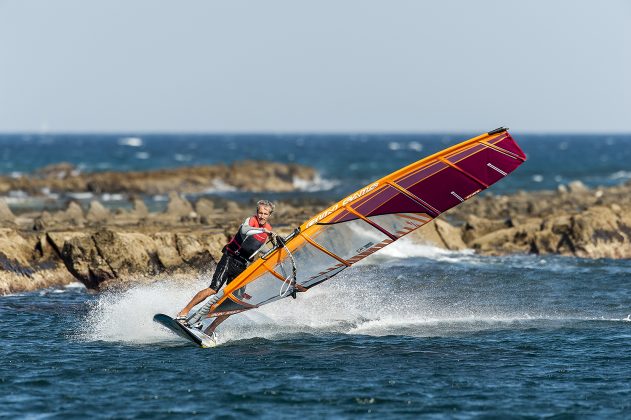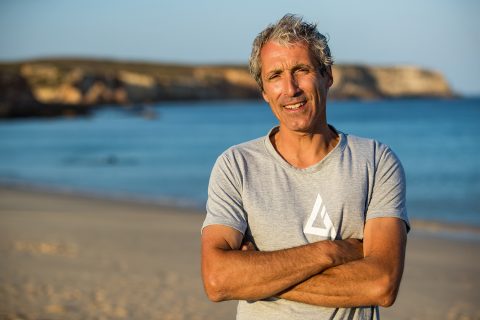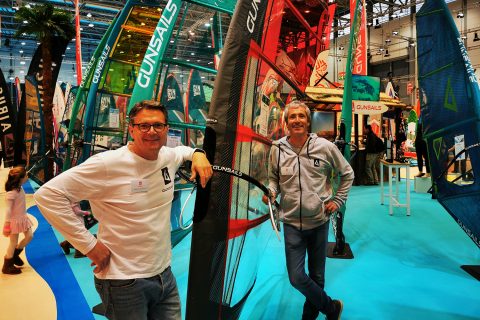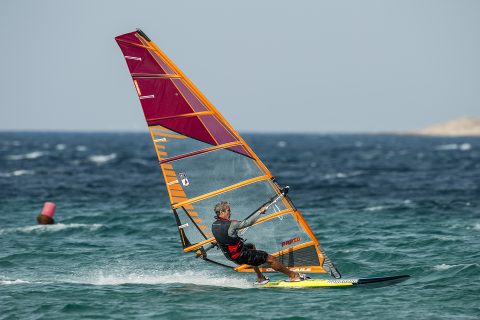PHILIPPE VIGNERON: GUNSAILS CHIEF TESTER
Philippe Vigneron grew up in the Vendée, near the French Atlantic coast. His parents were already windsurfing fanatics, and pulled him into the sport in the same way. Philippe is now chief sail tester for GunSails and based in Tarifa; Axel Reese sits down with him to get an insight into his work and background.
WORDS – Axel Reese, Philippe Vigneron // PHOTOS – Ludovic Franco (action), Pierre Bouras (portrait), GunSails.
AR: Philippe, your father sewed your first sail for you!
PV: Yes, my father made me a special small sail that was more manageable for me as a little boy, which I could then make good progress with on the water.
- Philippe Vigneron
AR: How did you become chief tester at GunSails in Tarifa?
PV: I helped Jochen Krauth and Victor Diaz (both ex-team riders at GunSails) with testing for a while, then Jochen wanted to work on racing boats. The door opened for me and GunSails hired me permanently in 2001. In the beginning, I spent a lot of time on the water testing as many sails as possible. There are so many parameters you can change on a sail, and the problem is not getting a feel for the sail’s characteristics and whether one sail feels lighter or is more “stable” than another, but understanding which part of the sail works well or not. So you need a lot of experience and communication and a really good cooperation with the sail designer is important to understand how to improve the performance.
AR: Almost every day you are out on the water testing sails. How does your own sensitivity to the rig change with the frequency and number of prototypes you test?
PV: From years of doing this, all my senses now focus faster and better to pick up details of the sail compared to when I first started. I correlate and compare that with information from sails and cuts I have sailed in the past. In the beginning this work on the water took much longer and we needed many more hours to reach conclusive results.
AR: What does a normal working day in Tarifa look like for you?
PV: We start at 10 a.m. in the loft and when the prototypes are ready and the conditions at the spots are right for testing, I go straight out on the water. When the test is finished, I come back to the loft for a debriefing with the GunSails designer, Renato Morlotti. We then talk about the changes we need to make, and we can normally make them immediately, and then I go back on the water. I’m usually done by 6 p.m., which can be later in the summer if there’s a thermal wind.
AR: You test the modified prototype on the same day?
PV: Yes, if the wind and water conditions are right, we can test up to two re-cuts a day.
AR: How many prototypes and re-cuts are there per sail size?
PV: It depends on each sail, but we usually do up to four prototypes with up to 5 re-cuts per size. For instance, we can maybe improve a 7.8 GS-R with just two prototypes, while a 5.6 GS-R needs six prototypes. Each size has its own luff curve; you can’t just project a 9.0 sail smaller to make an 8.0 sail! But of course, we also have a time limit with each sail, because each sail has to be put into production with a final cut on a fixed date.
AR: How many prototypes, including re-cuts, have you got your hands on as a tester in over 20 years?
PV: I don’t know! After 20 years, there must be a few thousand that I have tested on the water!
AR: Besides testing on the water, you work with Renato Morlotti in the loft in Facinas, north of Tarifa. What does your work in the loft look like?
PV: I know how to operate a sewing machine or change a mast curve, but Renato is better and faster than me! I work on masts by measuring new masts on a machine and I sand sail battens on a small machine.
AR: How do you divide your time between working on the water and in the loft?
PV: I think 30% on the water, 20% looking for good conditions (it’s always better to “push” the sail to its full range) and 30% with Renato (re-cuts, debriefings…). The rest is spent preparing the kit for testing.
AR: Do you always have the same impressions during the sail tests with your test partners?
PV: When a sail works well, everyone agrees. The riders I test with have more or less the same height and weight as me – 183 cm and 75 kg, which makes testing easier. In cases where they are very light or very heavy test partners, it can be different, because, for example, the very light rider tends to prefer softer sails.
I remember an anecdote about a German speed rider who wanted to go to Lüderitz in Namibia and wanted a very special sail without a loose-leech. I didn’t like the feel of the sail, but we did what he wanted.
AR: Do you talk to your test partner during the sail test about the impressions you have just gained?
PV: Good question! No, usually not, because I don’t want to influence my partner’s fresh impressions. After the test, we exchange ideas about the sail.
AR: Do you have to speak a common “language” with your test partner and the sail designer, i.e. articulate experiences in the same way so that they are understood?
PV: Yes, of course we speak the same “language”, after more than twenty years of collaboration, Renato knows exactly what I want to express. When I tell him that the tested sail generally needs to give more lift, he knows exactly what that means.
AR: Philippe, who do you talk to more, Renato or your wife?
PV: (Laughs!) Yes, we spend a lot of time together. Even after 22 years, we always want to improve our sails and ourselves. We push each other in the process and I couldn’t work with a guy if he was “satisfied”. And yes, we talk a lot.
AR: And your way of answering questions is so much like Renato’s!
PV: (Laughs!) Is that so? Yes, we’ve been working together for so long!
AR: Does it make a difference whether Renato or you test the sails?
PV: Of course it’s better if Renato comes along, because four eyes are even better than two, but Renato knows better how to change the sail.
AR: Other sail designers stand on the beach with binoculars and watch their team riders testing the sails.
PV: Yes, sometimes when I am on the water with a slalom sail, he watches how the sail looks and works.
AR: You have to be very physically fit for your job, don’t you?
PV: Yes, that’s the case. I stretch a lot every day and watch what I eat.
AR: What motivates you in your job?
PV: Making our sails even better and seeing windsurfers on the water who are happy with our sails and from whom we get great feedback.
- Philippe Vigneron blasting
AR: What is the best thing about this job?
PV: The process of making our sails even better is never ending!
AR: Away from the job, what does a holiday look like for you?
PV: I’m married and we have kids, so we like to spend time together and with our friends. We like to go sailing and windsurfing and spend time outside. Raising children is like a sail that never gets finished!
Philippe Vigneron
Nationality: French.
Date of birth: 10/11/1972.
Place of residence: Tarifa, Spain.
Windsurfing since: 1978.
First national regatta: 1991, 2nd place French Raceboard Championships.
First World Cup participation: 1998 in Almanarre, France.
Greatest successes: 5th place overall French Championships 2001, 3rd place Formula World Championships 2002.
Chief sail tester at GunSails since: 2001.





